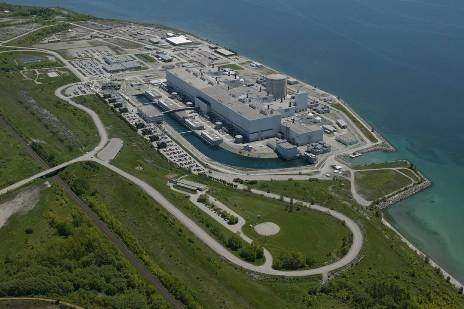The government of Ontario has kept nuclear at the centre of its updated long-term energy program, with major refurbishments planned for the Bruce and Darlington power stations. However, it has decided to defer the construction of new nuclear capacity.
 |
| Darlington: no new units for the time being (Image: OPG) |
Since 2003, Ontario has been working to transform its electricity sector into a clean, reliable and affordable system, and by the end of 2014 the province is set to be coal-free. The 2013 Long-Term Energy Plan (LTEP) published by Ontario's energy ministry sets out the province's plans going forward. Over the past decade increased energy efficiency and the changing economy have reduced Ontario's electricity demand, and the province now expects to be able to offset nearly all of the expected growth in electricity demand to 2032 using efficiency and conservation measures and minimising the need for new supply.
Ontario's three nuclear plants at Darlington, Bruce and Pickering are home to 18 of Canada's 19 operating power reactors, and generate around 50% of the province's electricity. The latest plan recognises the vital role that nuclear plays in its plans for a diverse and reliable energy supply, continuing to contribute 42% of Ontario's electricity supply in 2025. However, it no longer sees the need for new capacity to be built at Darlington as forecast under the previous LTEP, published in 2010.
Earlier this year, Ontario Power Generation (OPG) received detailed construction plans, schedules and cost estimates for the two reactor designs under consideration for new build at its Darlington site - Candu Energy's Enhanced Candu 6 and Westinghouse's AP1000. The new LTEP says that this capacity is not currently needed because electricity demand has not grown as expected. However, it intends to keep the new-build option open, working with OPG to maintain the licence granted by the Canadian Nuclear Safety Commission in 2012 for the project. Ontario continues to have the option to build new nuclear reactors in the future, should the supply and demand picture in the province change over time," the plan states.
Refurbishment of existing nuclear capacity has been identified as the most cost-effective way of continuing to meet Ontario's baseload generation requirements, and received strong support during the consultation process behind the LTEP. The province intends to press on with plans for refurbishments at Bruce and Darlington, effectively renewing the 8500 MWe of generating capacity over 16 years. The first units to undergo refurbishment will be Darlington 2 and Bruce 4, with work expected to start in the third quarter of 2016.
The province's oldest nuclear reactors at the six-unit Pickering plant are expected to remain in service until 2020, although an earlier shutdown "may be possible" depending on projected demand and the progress of the refurbishment program at the other plants.
According to Ontario's energy ministry, the latest plan has been reviewed in the longest and most comprehensive consultation and engagement process it has ever undertaken.
Researched and written
by World Nuclear News




_18570.jpg)
_18938.jpg)
_33584.jpg)
_82983.jpg)





